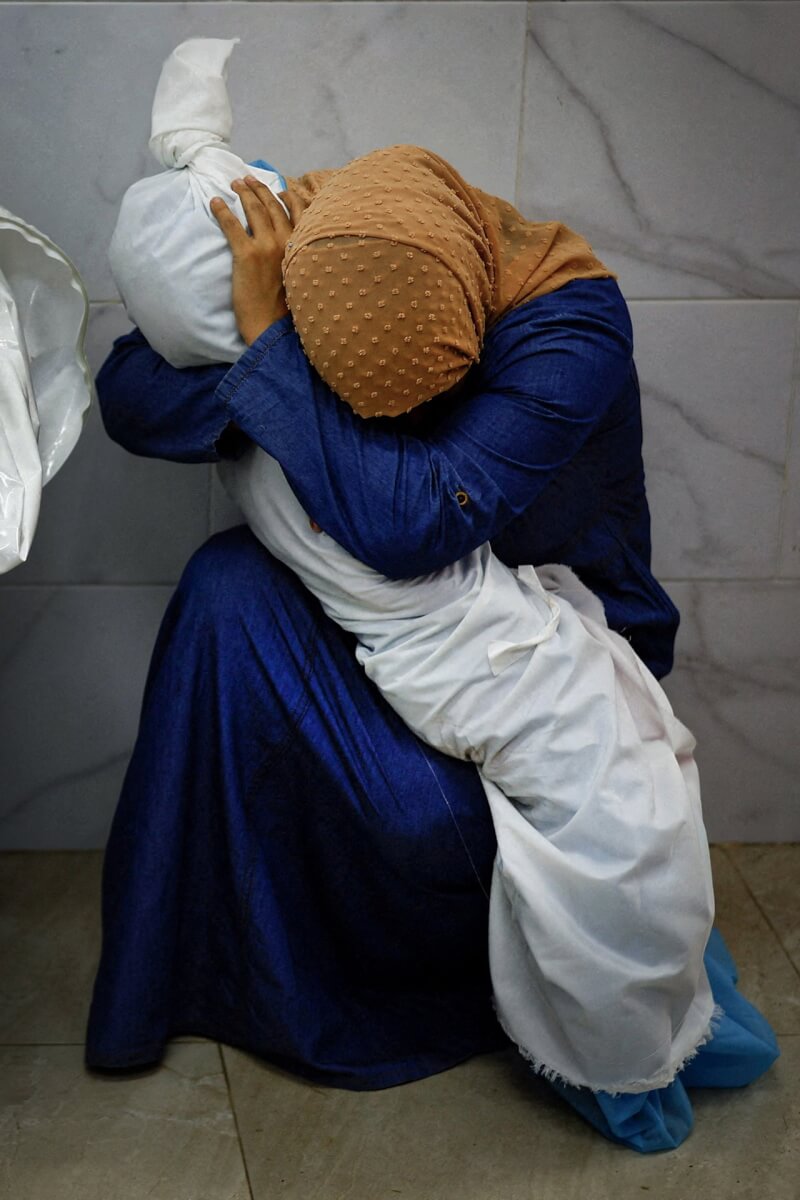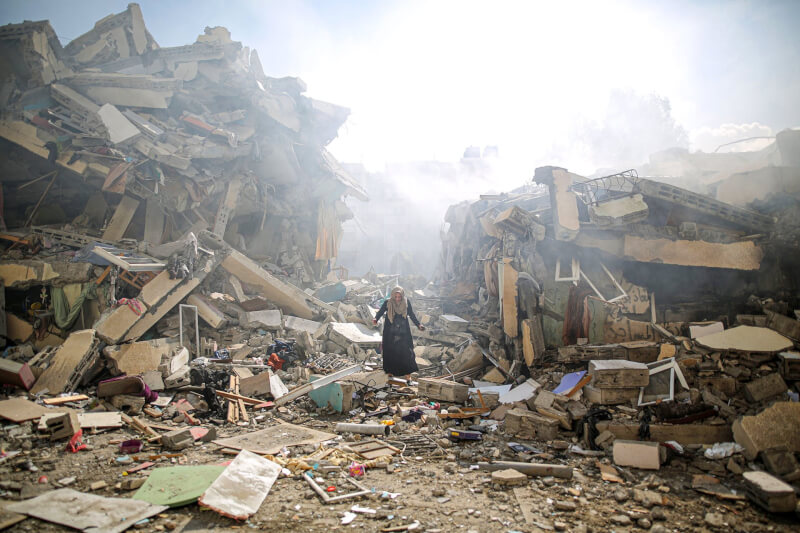
Inas Abu Maamar, 36, cradles the body of her five-year-old niece Saly, who was killed along with her mother and sister when an Israeli missile struck their home in Khan Younis, Gaza. The image by Reuters photographer Mohammed Salem won the World Press Photo of the Year.
[Mohammed Salem/Reuters/World Press Photo]
Rather than calling out the expanding legions of self-proclaimed “citizen journalists” and propagandists spreading lies under the guise of legitimate information, the “fake news” indictment has become a widely used weapon against so-called “corporate media,” the “left-wing press,” small-l “liberal hacks,” and unadulterated facts that some people don’t want in the public domain.
It’s one reason why organizations such as World Press Photo (WPP) are more important than ever.
Since it was created by a group of Dutch photographers in 1955, the independent, Amsterdam-based non-profit has been considered the ultimate arbiter of the best of visual journalism the world over.
This year, some 31 photographers, editors, curators, critics and executives reviewed 61,062 images by 3,851 photographers from 130 countries, awarding 24 winners, six honorable mentions and two jury special mentions from the 2023 crop.
Since the onset of digital photography and the continuing evolution of the software designed to process it, scandals and controversies briefly shook the contest, as they did much of the news industry. Ironically, the most serious of these WPP incidents had nothing to do with photo manipulation: The 2015 contest winner was stripped of his prize for staging some of his pictures.
Contest rules, ethics codes and verification processes were reworked, ultimately rendering them an industry standard. They include requirements for RAW or unedited jpeg images to accompany edited entries, and exhaustive fact-checking processes by external research teams, along with outright bans on multiple exposures, stitching and adding or “Photoshopping” out content.
Its panels of judges then announce their results in multiple categories and the organization releases the pictures to the world as examples of the trade’s highest achievements and most powerful images.

An Israeli security forces officer searches the site of the Supernova music festival for personal effects of victims of the Oct. 7, 2023, attack by Hamas. About 1,200 people were killed, some 2,500 wounded and another 250 taken hostage from the festival and communities around Re’im, Israel, near the Gaza border.
[Leon Neal/Getty Images/World Press Photo]
It’s a photograph of 36-year-old Inas Abu Maamar cradling the body of her five-year-old niece Saly after the child was killed along with her mother and sister when an Israeli missile struck their home in Khan Younis, Gaza.
Taken just days after his own wife gave birth, photographer Mohammed Salem of Britain’s Reuters news agency described the image as a “powerful and sad moment that sums up the broader sense of what was happening in the Gaza Strip.”
He found Maamar squatting on the floor, embracing her niece’s remains, at the Nasser Hospital morgue, where residents were going to search for missing relatives. The woman had raced to the family home when she heard that it had been hit, then on to the morgue.
“The jury was deeply moved by how this image evokes an emotional reflection in every viewer,” said the judges. “Composed with care and respect, it offers at once a metaphorical and literal glimpse into unimaginable loss.
“Set in a geographically distant medical setting, it resonates globally, urging us to confront our desensitization of the consequences of human conflict.”
It’s just the second time an image from the longstanding conflict has taken the top prize at WPP. The last one, of Palestinian children raising their toy guns in the air, was taken by celebrated Canadian photojournalist Larry Towell in 1994.
Wars have formed the bulk of the WPP’s top pictures—Vietnam, Lebanon, Kosovo, Chechnya, Afghanistan, Iraq, Ukraine.
The latest Israeli offensive on the Palestinian enclave in Gaza began after Hamas militants crossed the border last Oct. 7 and attacked multiple sites in Israel, killing some 1,200 people, including at least seven Canadians. More than 2,500 were wounded and some 250 hostages were taken.
The Palestinian health ministry said on April 17 that at least 33,899 Palestinians have been killed and 76,664 wounded since. The United Nations Office for the Coordination of Human Affairs put the preliminary number of confirmed dead at fewer than 500, with some 4,800 wounded. It said more complete figures would be available “once these incidents have been independently verified.”

A resident of al-Zahra, Gaza, walks through the rubble of homes destroyed in Israeli airstrikes. The strikes hit around 25 apartment blocks in the university and residential neighborhood.
[Mustafa Hassouna/Anadoula Images/World Press Photo]
Ham-fisted video recently purported to uncover Palestinian attempts to fake scenes in a hospital emergency ward filled with civilians wounded in an Israeli rocket attack (as if such a scene would need faking). But it was evident the supposed exposé was, itself, fake.
Pictures, however, don’t lie. At least, not at World Press Photo. They may not bring clarity to the numbers, but they take viewers to the heart of the matter—personal tragedy and loss.
Getty Images’ Leon Neal photographed an Israeli security forces officer searching the border site of the Supernova music festival for personal effects of victims in the hours following the Oct. 7 attacks. Their scattered belongings suggested the panic that ensued as the terrorists closed in, weapons blazing.
Veteran photojournalist Mustafa Hassouna of Turkey’s Anadolu Images, digital platform of the region’s century-old news service, Anadolu Ajansı (AA), shows a resident walking through rubble in the devastated university and residential Gaza neighbourhood of al-Zahra, where air strikes took out about 25 apartment blocks.
The two photos were awarded rare Jury Special Mentions.
“These two special mentions reflect the gravity of the Israel-Hamas war in 2023, the extreme suffering of civilians, and its global political impact,” said the judges.
“While each photograph shows a single individual in the aftermath of a horrific attack, the contrast between the scenes helps viewers understand the differing scales of devastation without minimizing the individual suffering.
“We also wish to pay tribute to photographers reporting on this war, who are subjected to huge amounts of trauma, risk, and personal loss, particularly in Gaza.”
Sixteen journalists were reported injured, four were missing and 25 arrested.
Indeed, the Committee to Protect Journalists (CPJ), which produces an annual report on news media deaths worldwide, said on April 19 that at least 97 journalists and media workers had been killed in the conflict since it began: 92 Palestinians, two Israelis and three Lebanese.
Another 16 journalists were reported injured, four were missing and 25 arrested.
The Israel Defense Forces told the Reuters and Agence France-Press news agencies in October that it could not guarantee the safety of their journalists operating in the Gaza Strip, after they had sought assurances that they would not be targeted by Israeli strikes, according to a Reuters report.
“Journalists in Gaza face particularly high risks as they try to cover the conflict during the Israeli ground assault,” said the committee, “including devastating Israeli airstrikes, disrupted communications, supply shortages, and extensive power outages.”
The CPJ was also investigating “numerous” unconfirmed reports of other journalists killed, missing, detained, wounded or threatened, and of damage to media offices and journalists’ homes.
“Since the Israel-Gaza war began, journalists have been paying the highest price— their lives—to defend our right to the truth,” said the organization’s New York-based program director, Carlos Martínez de la Serna. “Each time a journalist dies or is injured, we lose a fragment of that truth.
“Journalists are civilians who are protected by international humanitarian law in times of conflict. Those responsible for their deaths face dual trials: one under international law and another before history’s unforgiving gaze.”
Advertisement




















